Test: 35 Year JEE Previous Year Questions: Ray & Wave Optics - JEE MCQ
30 Questions MCQ Test 35 Years Chapter wise Previous Year Solved Papers for JEE - Test: 35 Year JEE Previous Year Questions: Ray & Wave Optics
The figure shows a surface XY separating two transparent media, medium-1 and medium-2. The line ab and cd represent waveforms of a light wave travelling in medium-1 and incident on XY. The lines ef and gh represent wavefronts of the light wave in medium2 after refraction.

Q. Light travels as a

The figure shows a surface XY separating two transparent media, medium-1 and medium-2. The line ab and cd represent waveforms of a light wave travelling in medium-1 and incident on XY. The lines ef and gh represent wavefronts of the light wave in medium2 after refraction.
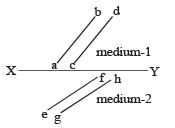
Q. The phases of the light wave at c, d, e and f are φc, φd, φe and φf respectively. It is given that φc ≠ φf.

| 1 Crore+ students have signed up on EduRev. Have you? Download the App |
The figure shows a surface XY separating two transparent media, medium-1 and medium-2. The line ab and cd represent waveforms of a light wave travelling in medium-1 and incident on XY. The lines ef and gh represent wavefronts of the light wave in medium2 after refraction.
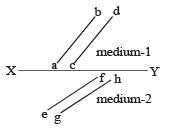
Q. Speed of light is

Most materials have the refractive index, n > 1. So, when a light ray from air enters a naturally occurring material, then by Snell’s law,  it is understood that the refracted ray bends towards the normal. But it never emerges on the same side of the normal as the incident ray. According to electromagnetism, the refractive index of the medium is given by the relation, n= c /
it is understood that the refracted ray bends towards the normal. But it never emerges on the same side of the normal as the incident ray. According to electromagnetism, the refractive index of the medium is given by the relation, n= c /  where c is the speed of electromagnetic waves in vacuum, v its speed in the medium, εr and μr are the relative permittivity and permeability of the medium respectively.
where c is the speed of electromagnetic waves in vacuum, v its speed in the medium, εr and μr are the relative permittivity and permeability of the medium respectively.
In normal materials, both εr and μr , are positive, implying positive n for the medium. When both εr and μr are negative, one must choose the negative root of n. Such negative refractive index materials can now be artificially prepared and are called metamaterials. They exhibit significantly different optical behavior, without violating any physical laws. Since n is negative, it results in a change in the direction of propagation of the refracted light.
However, similar to normal materials, the frequency of light remains unchanged upon refraction even in meta-materials.
Q. For light incident from air on a meta-material, the appropriate ray diagram is
Most materials have the refractive index, n > 1. So, when a light ray from air enters a naturally occurring material, then by Snell’s law,  it is understood that the refracted ray bends towards the normal. But it never emerges on the same side of the normal as the incident ray. According to electromagnetism, the refractive index of the medium is given by the relation, n= c /
it is understood that the refracted ray bends towards the normal. But it never emerges on the same side of the normal as the incident ray. According to electromagnetism, the refractive index of the medium is given by the relation, n= c /  where c is the speed of electromagnetic waves in vacuum, v its speed in the medium, εr and μr are the relative permittivity and permeability of the medium respectively.
where c is the speed of electromagnetic waves in vacuum, v its speed in the medium, εr and μr are the relative permittivity and permeability of the medium respectively.
In normal materials, both εr and μr , are positive, implying positive n for the medium. When both εr and μr are negative, one must choose the negative root of n. Such negative refractive index materials can now be artificially prepared and are called metamaterials. They exhibit significantly different optical behavior, without violating any physical laws. Since n is negative, it results in a change in the direction of propagation of the refracted light.
However, similar to normal materials, the frequency of light remains unchanged upon refraction even in meta-materials.
Q. Choose the correct statement.
Light guidance in an optical fibre can be understood by considering a structure comprising of thin solid glass cylinder of refractive index n1 surrounded by a medium of lower refractive index n2.
The light guidance in the structure takes place due to successive total internal reflections at the interface of the media n1 and n2 as shown in the figure. All rays with the angle of incidence i less than a particular value im are confined in the medium of refractive index n1. The numerical aperture (NA) of the structure is defined as sin im.
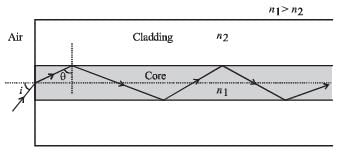
Q. For two structure namely S1 with  and n2 = 3/2, and S2 with n1 = 8/5 and n2 = 7/5 and taking the refractive index of water to be 4/3 and that of air to be 1, the correct option(s) is(are)
and n2 = 3/2, and S2 with n1 = 8/5 and n2 = 7/5 and taking the refractive index of water to be 4/3 and that of air to be 1, the correct option(s) is(are)
Light guidance in an optical fibre can be understood by considering a structure comprising of thin solid glass cylinder of refractive index n1 surrounded by a medium of lower refractive index n2.
The light guidance in the structure takes place due to successive total internal reflections at the interface of the media n1 and n2 as shown in the figure. All rays with the angle of incidence i less than a particular value im are confined in the medium of refractive index n1. The numerical aperture (NA) of the structure is defined as sin im.
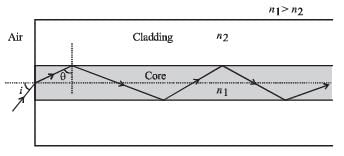
Q. If two structure of same cross-sectional area, but different numerical apertures NA1 and NA2(NA2 < NA1) are joined longitudinally, the numerical aperture of the combined structure is
STATEMENT-1 The formula connecting u, v and f for a spherical mirror is valid for mirrors whose sizes are very small compared to their radii of curvature. because
STATEMENT-2 Laws of reflection are strictly valid for plane surfaces, but not for large spherical surfaces.
An astronomical telescope has a large aperture to
If two mirrors are kept at 60° to each other, then the number of images formed by them is
Electromagnetic waves are transverse in nature is evident by
Wavelength of light used in an optical in strument are λ1= 4000 Å and λ2 = 5000 Å , then ratio of their respective resolving powers (corresponding to λ1 and λ2) is
Which of the following is used in optical fibres?
Consider telecommunication through optical fibres. Which of the following statements is not true?
To demonstrate the phenomenon of interference, we require two sources which emit radiation
The image formed by an objective of a compound microscope is
To get three images of a single object, one should have two plane mirrors at an angle of
A light ray is incident perpendicularly to one face of a 90° prism and is totally internally reflected at the glass-air interface. If the angle of reflection is 45°, we conclude that the refractive index n
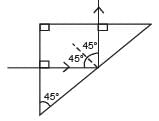
A plano convex lens of refractive index 1.5 and radius of curvature 30 cm. Is silvered at the curved surface. Now this lens has been used to form the image of an object. At what distance from this lens an object be placed in order to have a real image of size of the object
The angle of incidence at which reflected light is totally polarized for reflection from air to glass (refractive index n), is
The maximum number of possible interference maxima for slit-separation equal to twice the wavelength in Young’s double-slit experiment is
An electromagnetic wave of frequency n = 3.0 MHz passes from vacuum into a dielectric medium with permittivity ∈ = 4.0 . Then
A fish looking up through the water sees the outside world contained in a circular horizon. If the refractive index of water is 4/3 and the fish is 12 cm below the surface, the radius of this circle in cm is
Two point white dots are 1 mm apart on a black paper. They are viewed by eye of pupil diameter 3 mm. Approximately, what is the maximum distance at which these dots can be resolved by the eye? [Take wavelength of light = 500 nm]
A thin glass (refractive index 1.5) lens has optical power of – 5 D in air. Its optical power in a liquid medium with refractive index 1.6 will be
A Young’s double slit experiment uses a monochromatic source. The shape of the interference fringes formed on a screen is
If I0 is the intensity of the principal maximum in the single slit diffraction pattern, then what will be its intensity when the slit width is doubled?
When an unpolarized light of intensity I0 is incident on a polarizing sheet, the intensity of the light which does not get transmitted is
The refractive index of a glass is 1.520 for red light and 1.525 for blue light. Let D1 and D2 be angles of minimum deviation for red and blue light respectively in a prism of this glass.
Then,
In a Young’s double slit experiment the intensity at a point where the path difference is λ/6 (λ being the wavelength of light used) is I. If I0 denotes the maximum intensity,  equal to
equal to
|
347 docs|185 tests
|
|
347 docs|185 tests
|



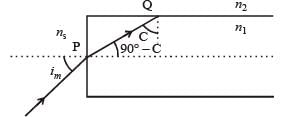

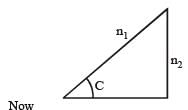
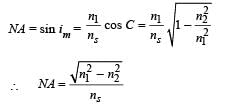
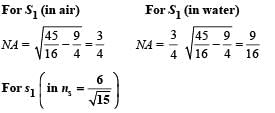




 is valid only for mirrors of small apertures where the size of aperture is very small as compared to the radius of curvature of the mirror. This statement is true.
is valid only for mirrors of small apertures where the size of aperture is very small as compared to the radius of curvature of the mirror. This statement is true. where D = diameter of the objective lens
where D = diameter of the objective lens





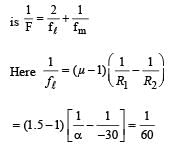









 .... (i)
.... (i)
 ... (ii)
... (ii)




 is the maximum intensity..
is the maximum intensity..
















